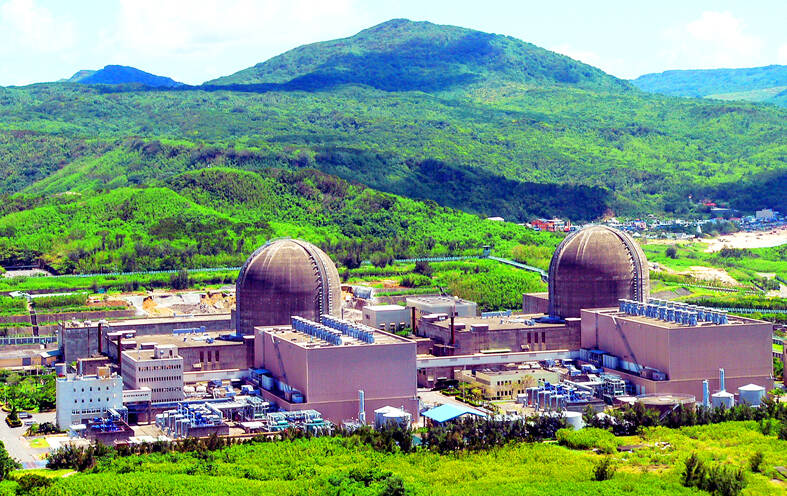The closure of the No. 1 reactor at the Ma-anshan Nuclear Power Plant in Pingtung County’s Ma-anshan (馬鞍山) comes amid a continuing debate among lawmakers about whether to extend the service life of the nation’s existing atomic energy facilities.
Before the closing of the No. 1 reactor, nuclear power accounted for about 5 percent of the nation’s energy use, which is dominated by coal and liquefied natural gas (LNG).

The Ma-anshan Nuclear Power Plant in Pingtung County is pictured in an undated photograph.
Photo courtesy of the Taiwan Power Co
The state-run Taiwan Power Co (Taipower, 台電) yesterday said that with the closure of the No. 1 reactor, the total percentage of power generated by nuclear sources would fall to 2.8 percent.
To assuage public concern regarding power stability, the Ministry of Economic Affairs said it has negotiated with Sun Ba Power Corp (森霸電力) to use the power generated from its No. 3 LNG unit to buttress the power generation shortfall.
The unit can generate 1,100 megawatts, which is greater than the 951 megawatts put out by the Ma-anshan Nuclear Power Plant’s No. 1 reactor, the ministry said.
However, phasing out nuclear power generation and replacing it with LNG would bring other challenges regarding power prices and carbon emissions, industry observers said.
Energy security is a critical issue in Taiwan and its chipmaking industry, led by Taiwan Semiconductor Manufacturing Co (台積電).
The issue has taken on added importance as Beijing exerts more pressure on Taipei.
The tensions are stoking concerns that China could potentially limit Taiwan’s energy supplies through a military blockade.
The 2011 meltdown at the Fukushima Dai-ichi nuclear power plant in Japan helped turn popular opinion in Taiwan against the industry.
The government said it would not rule out boosting nuclear power’s share of the energy mix, but said the technology needs to improve.
The last reactor at the Ma-anshan Nuclear Power Plant is set to close in May next year. Both it and the No. 1 reactor’s closing are planned retirements after about 40 years of use.
The moves buck a global trend of renewed interest in nuclear energy, which produces no greenhouse gas emissions, but results in toxic waste that can remain radioactive for millennia.
Lawmakers this month debated for hours over whether to reverse course on the government’s plan to completely phase out nuclear power, although no vote was taken.
The use of nuclear energy has long been a source of contention between the ruling and opposition parties.
When the Democratic Progressive Party took office in 2016, then-president Tsai Ing-wen (蔡英文) said her goal was to make Taiwan nuclear-free by next year, setting a target energy mix of 50 percent natural gas, 30 percent coal and 20 percent renewables.
Opposition parties have advocated restarting nuclear reactors.
Taiwan now expects renewable energy to comprise one-quarter of its energy mix by 2030, up from about 12 percent this year.
Power consumption is forecast to grow by an average of 2.8 percent a year through 2033, driven by the artificial intelligence sector.
While Taiwan has a surplus of electricity, according to Premier Cho Jung-tai (卓榮泰), that growth could crimp the excess supply in the years ahead.